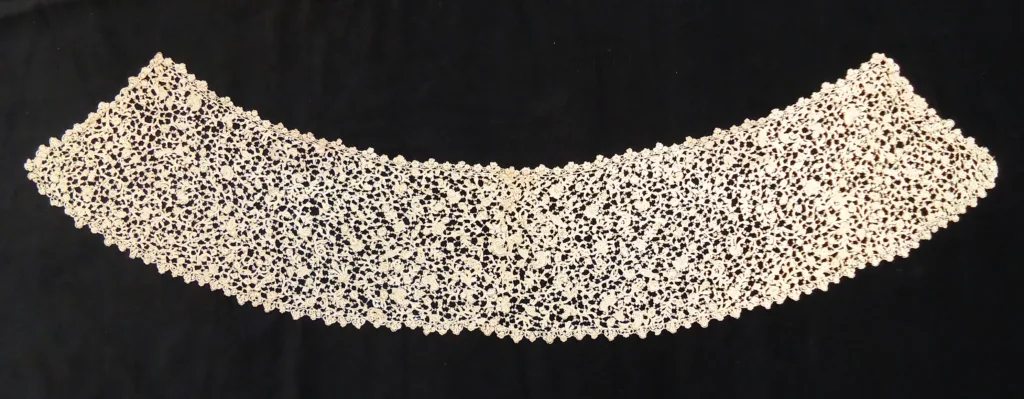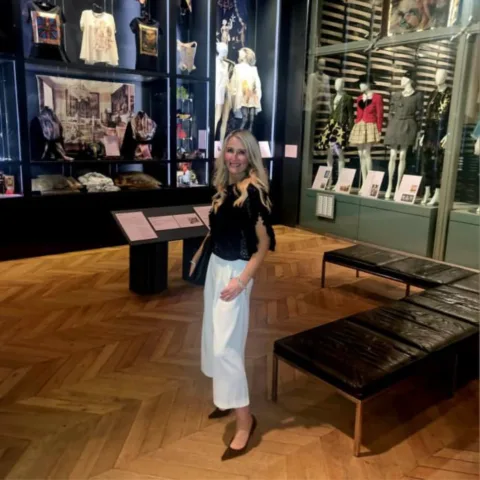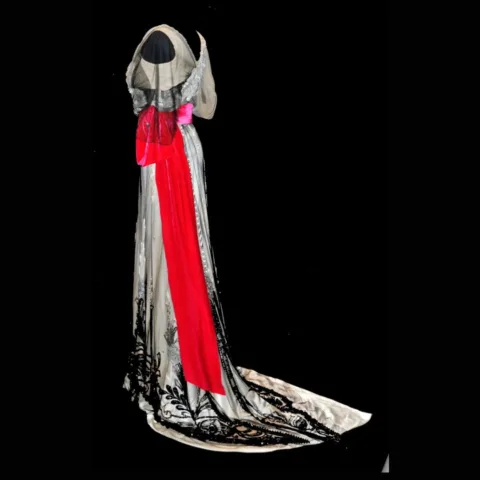The Bowes Museum Blog

350 Year Old Italian Collar, Seeks 350 Year Old British Dress for Meaningful Short-Term Relationship

Last week I couriered a collar from our Blackborne Lace collection to the National Maritime Museum in Greenwich, for their forthcoming Samuel Pepys: Plague, Fire, and Revolution exhibition.
The lace itself [2007.1.1.162] dates to the mid-17th century, the technique is needle lace, and it was made in Venice. The shape of the collar was altered in the later 19th century at the Blackborne & Co. shop in South Audley Street London, reflecting changing tastes and styles. Contemporary 17th century paintings give us an indication of how the collar would have appeared when worn. This painting, from our own collection, shows Maria Anna van Berchem (1638-1663) (not her mother, as the title of the painting indicates) wearing a deep collar of Venetian needle lace. Our lace collar was to be displayed on a silver-tissue court dress from the Fashion Museum, Bath, originally worn by Theophilia Harris in the 1660s.When Theophilia wore her dress 350 years ago, both the dress and lace would have been newly made, and pinned, or perhaps stitched into position for the day or evening that she was present at court, in his majesty’s presence. The challenge now was to attach the lace to the dress in a much more non-intrusive way.
To achieve this, the lace collar was mounted onto a piece of soft, nylon conservation net, which was colour-matched to the dress, so that it visually blends in once laid over the top. The lace was secured around all it’s edges with a long-and-short stitch in fine polyester thread (colour-matched to the lace so that it disappears from sight).
The net was then carefully trimmed around the lower and side edges, leaving an extension at the top edge.
This net extension was then folded back on itself, and secured with a secondary line of stitching, holding the net extension downwards, this spare piece of fabric being tucked in place between the front of the dress, and the replica chemise.
The collar would have followed closely the neckline of the dress, however, as the shape of this collar has been altered, the ends sit lower over the shoulder blades. For additional security, a very fine entymological pin was used to secure the corner of the collar to the dress, pushed through a seam so as not to leave a hole in the dress fabric.
Samuel Pepys: Plague, Fire & Revolution runs at the National Maritime Museum, Greenwich from the 20th November 2015 until the 28th March 2016.
For more posts about our Blackborne Lace collection, and some of the conservation work that we have carried out on it, see: What’s In The Box?; Washing Bonnets for Common Grounds; Feathers Are Out & Lace Is In: Exhibition Changeover; From Regal to the Every Day: Hidden Drawers to Common Grounds.
Katy Smith, Textile Conservator

![Collar of 17th C. Venetian needle lace, altered in the 19th C. [2007.1.1.16]](https://thebowesmuseum.files.wordpress.com/2015/11/photoshopped.jpg?w=660)













